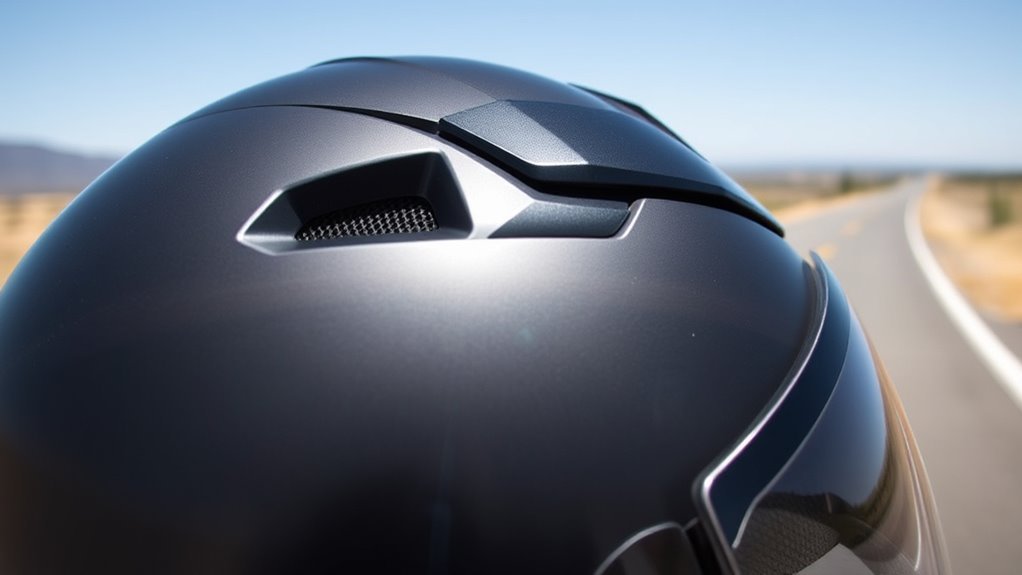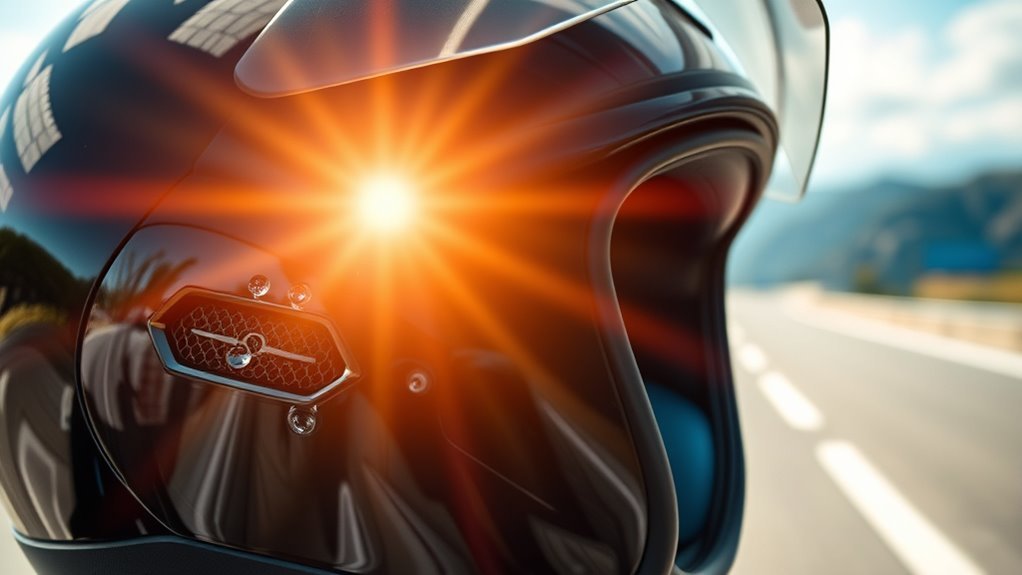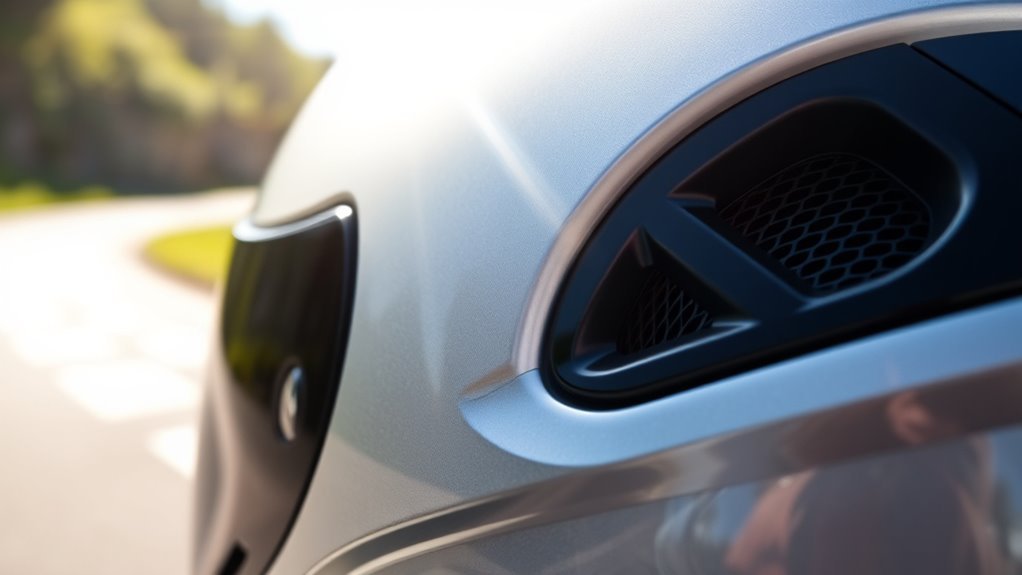Importance of Ventilation in Motorcycle Helmets
Ventilation in motorcycle helmets is essential for your comfort and safety. It regulates temperature, enhances airflow, and minimizes humidity, preventing distractions during rides. With proper ventilation, you’ll experience reduced heat buildup and moisture retention, which supports better focus and visibility. Effective airflow systems, whether passive or active, play a significant role in maintaining a clear line of sight and promoting a snug fit for peak safety. You’ll discover more about how to select the right helmet for your needs.
The Role of Ventilation in Rider Comfort

While many riders focus on safety features when selecting a motorcycle helmet, the importance of ventilation should not be overlooked, as it greatly affects overall comfort during rides. Effective ventilation systems utilize advanced breathability materials designed to enhance airflow, minimizing heat buildup and moisture retention. When you’re cruising down the highway, proper airflow is essential to keep you cool and focused. Helmets with adjustable vents allow you to make comfort adjustments based on weather conditions, providing a customized experience. Without adequate ventilation, discomfort can lead to distractions, undermining the freedom you seek while riding. Ultimately, selecting a helmet with ideal ventilation guarantees you stay comfortable, enabling you to embrace the open road with confidence and ease.
Impact of Airflow on Safety and Performance

Effective airflow in your helmet greatly influences both safety and performance during rides. By enhancing visibility and focus, regulating temperature, and controlling moisture, proper ventilation systems can reduce distractions and fatigue. Understanding these benefits is essential for maximizing your riding experience and maintaining ideal concentration on the road.
Enhanced Visibility and Focus
As airflow within a motorcycle helmet enhances visibility, it plays an essential role in maintaining rider focus and safety. Effective ventilation systems allow for a continuous exchange of air, reducing fogging on the visor and ensuring a clear line of sight. This visibility enhancement not only helps you stay aware of your surroundings but also minimizes distractions that could compromise your performance. Additionally, improved airflow supports focus improvement by preventing fatigue and discomfort associated with stale air. When you can see clearly and maintain concentration, your decision-making skills sharpen, leading to safer riding experiences. Ultimately, a well-ventilated helmet isn’t just about comfort; it’s a vital element for maximizing your freedom on two wheels.
Temperature Regulation Benefits
When riding, maintaining an ideal temperature within your helmet is essential for both safety and performance. Effective airflow dynamics are vital; they help regulate thermal comfort, preventing overheating during long rides. When air circulates efficiently, it dissipates heat generated by your head, which can greatly enhance your focus and reaction times. A well-ventilated helmet minimizes the risk of fatigue, allowing you to stay attentive and in control. Conversely, inadequate airflow can lead to discomfort and distraction, compromising your safety on the road. By prioritizing helmets with superior ventilation systems, you’re investing in not just comfort but also enhanced performance, ensuring that every ride feels liberating and secure. Make airflow a priority; your ride depends on it.
Moisture Control Mechanism
Although many riders may overlook the significance of moisture control in their helmets, inadequate airflow can lead to a dangerous buildup of humidity. This moisture buildup not only compromises comfort but can also impair visibility through helmet visors due to fogging. Effective humidity control is vital for maintaining a clear line of sight and ensuring safety while riding. Ventilation systems that promote consistent airflow help to dissipate moisture, reducing condensation and enhancing your overall riding experience. Additionally, proper moisture control can prevent discomfort and distractions, allowing you to focus on the freedom of the open road. Ultimately, a well-ventilated helmet is an essential component of your gear, optimizing both safety and performance through effective moisture management.
Types of Ventilation Systems in Helmets

When selecting a helmet, understanding the types of ventilation systems is essential for your comfort and safety. You’ll encounter passive ventilation designs that rely on airflow dynamics, active ventilation features that use mechanical means to enhance airflow, and adjustable options that allow you to customize ventilation levels. Each system has distinct advantages, influencing both thermal regulation and noise levels during your ride.
Passive Ventilation Design
Passive ventilation design in motorcycle helmets plays a critical role in maintaining rider comfort and safety, particularly during long rides or in warm conditions. These systems utilize strategically placed vents and air channels that leverage airflow dynamics to enhance passive cooling. By allowing fresh air to enter and stale air to exit, they create a natural flow that helps regulate temperature without the need for mechanical assistance. You’ll notice that many helmets feature front vents, exhaust ports, and internal airflow channels, all optimized for maximum efficiency. This design not only reduces heat buildup but also minimizes moisture accumulation, keeping your helmet comfortable and dry. Ultimately, effective passive ventilation is essential for a more enjoyable and liberating riding experience.
Active Ventilation Features
While passive ventilation is effective under certain conditions, active ventilation features take helmet airflow to the next level by mechanically enhancing air circulation. These systems often integrate fans or pumps, creating active airflows that efficiently draw in fresh air and expel stale air. This technology is particularly beneficial during high-speed rides or in warmer climates, where passive systems may struggle. Advanced helmet design incorporates strategically placed vents that work in conjunction with these active features, optimizing airflow without compromising safety. Additionally, some models allow you to adjust fan speeds, tailoring the ventilation to your comfort level. By embracing active ventilation, you not only boost your riding experience but also maintain clarity and focus, essential for the freedom of the open road.
Adjustable Ventilation Options
Adjustable ventilation options in motorcycle helmets provide riders with the ability to customize airflow based on varying conditions and personal preferences. These systems typically feature adjustable vents, allowing you to manipulate air intake for ideal comfort. Depending on your riding environment, you can increase airflow control on hot days or reduce it in cooler conditions, enhancing your overall experience. Many helmets offer multiple settings, enabling fine-tuning to match your needs. Whether you prefer maximum ventilation for a spirited ride or a more closed system for long journeys, the flexibility of adjustable vents guarantees you maintain comfort without sacrificing safety. Ultimately, this adaptability empowers you to embrace the freedom of the open road while keeping your head cool and focused.
How Ventilation Affects Temperature Regulation
Effective ventilation in motorcycle helmets is essential for maintaining ideal temperature regulation, especially during prolonged rides in varying environmental conditions. Proper airflow dynamics enable you to achieve a temperature balance, reducing heat buildup inside the helmet and enhancing comfort.
| Ventilation Type | Effect on Temperature | Ideal Conditions |
|---|---|---|
| Open Vents | Increases airflow | Hot weather |
| Adjustable Vents | Customizable flow | Varying climates |
| Closed Vents | Retains warmth | Cold weather |
| Multi-Channel Vents | Optimizes airflow | All conditions |
Choosing the Right Helmet With Optimal Ventilation
When selecting a motorcycle helmet, understanding the importance of ideal ventilation is critical, as it directly impacts your comfort and safety during rides. Look for helmets constructed with advanced ventilation materials that enhance airflow, ensuring you stay cool even on long journeys. A well-ventilated helmet not only reduces moisture build-up but also minimizes fatigue. Equally important is achieving the right helmet fit; a snug, yet comfortable fit allows for peak ventilation flow. If the helmet’s fit is too loose or tight, airflow could be obstructed, negating the benefits of your chosen ventilation system. Prioritize helmets designed with adjustable vents, giving you the freedom to customize airflow based on your riding conditions and personal comfort preferences.
Maintenance Tips for Keeping Ventilation Effective
To maintain ideal ventilation in your motorcycle helmet, regular cleaning and inspection are essential. Effective ventilation maintenance guarantees maximum airflow management, enhancing your riding experience. Follow these tips to keep your helmet’s ventilation system in top condition:
- Clean the vents: Remove dirt and debris blocking airflow.
- Inspect for damage: Regularly check for cracks or broken components.
- Replace filters: If your helmet includes filters, make sure they’re replaced as needed.
- Store properly: Keep your helmet in a cool, dry place to prevent mold and deterioration.
Frequently Asked Questions
Can Ventilation Systems Be Modified for Better Airflow?
Yes, ventilation systems can be modified for better airflow. You can achieve significant airflow improvements through ventilation upgrades such as adding or adjusting vents, using moisture-wicking liners, or incorporating fans. Analyzing the helmet’s design and airflow dynamics is essential; optimizing the placement and size of vents can enhance cooling. Remember, the goal is to maintain comfort without compromising safety, allowing you the freedom to ride longer and more comfortably.
Does Helmet Ventilation Affect Noise Levels While Riding?
Yes, helmet ventilation does affect noise levels while riding. The airflow dynamics created by ventilation systems can either amplify or reduce noise. If airflow is too unrestricted, wind noise increases, potentially disturbing your ride. Conversely, a well-designed ventilation system can balance airflow, improving comfort while minimizing noise intrusion. By optimizing these factors, you can maintain a sense of freedom and focus on the road ahead without excessive distractions from external sounds.
How Does Weather Impact Helmet Ventilation Effectiveness?
Weather conditions can dramatically impact your helmet’s ventilation effectiveness. Imagine riding through a summer storm—humidity clogs airflow dynamics, making your helmet feel like a sauna. Conversely, chilly winds can enhance ventilation but may chill you too much. A well-ventilated helmet balances these elements, ensuring you stay comfortable regardless of the weather. When choosing a helmet, consider how different weather conditions can influence airflow, keeping your ride enjoyable and safe.
Are There Specific Ventilation Features for Different Riding Styles?
Yes, there are specific ventilation features tailored for different riding styles. For sport touring, helmets often have adjustable vents that enhance airflow during high-speed rides while minimizing wind noise. In contrast, off-road helmets typically feature larger, more open vents to maximize airflow and allow for better cooling in rugged conditions. These designs cater to the unique demands of each riding style, ensuring you stay comfortable and focused, regardless of the terrain.
What Materials Enhance Ventilation in Motorcycle Helmets?
Using materials like mesh liners and strategically designed airflow channels can greatly enhance ventilation in motorcycle helmets. In fact, helmets with effective airflow systems can reduce heat buildup by up to 30%. Mesh liners allow for better air exchange, while airflow channels direct fresh air in and hot air out. This combination not only keeps you cooler but also improves comfort during long rides, giving you the freedom to enjoy the road without distraction.






